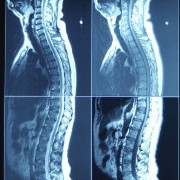Scoliosis is most commonly thought of as a spine problem of adolescence, but it can progress or even begin in adulthood. Scoliosis is a lateral or sideways curve in the spine. The curve may go to the left or the right. It can be mild, or cause severe deformity requiring surgery.
The most common scoliosis curve is a thoracic curve to the right. As the spine makes the lateral curve it also rotates on the long axis, causing vertebral bodies to turn. The turning of the vertebrae can cause ribs and the shoulder blade to protrude on one side or make the pelvis uneven resulting in the appearance of uneven leg lengths.
Pain is usually the symptom that drives an adult to seek treatment for scoliosis. There may also be stiffness and difficulty with sitting or standing for any length of time. In severe cases, the deformity of the thoracic spine and rib cage can cause shortness of breath due to pressure on the lungs and heart, but those cases are rare. There can be nerve dysfunction and spinal stenosis as well. The most severe pain is usually seen in cases of lumbar curvature.
There are several causes of adult onset scoliosis. Trauma, paralysis, tumor, herniated disc or sciatic pain can cause scoliosis. Osteoporosis and vertebral compression fractures may also be a cause. Undiagnosed childhood scoliosis may progress in adulthood.
Treatment of adult scoliosis does not usually require surgery. Most often treatment includes exercise or physical therapy, moist heat, and pain medication. Bracing is not helpful in adult scoliosis except when it may decrease pain. It will not treat or cure the deformity. Curves under 40 degrees typically remain stable, and if there are not symptoms they do not require treatment.
Cases with severe deformity, intractable pain or progressive neurological symptoms may be treated with surgery. Surgery can involve discectomy along with fusion to minimize the curve and stabilize the spine. Instrumentation such as rods, screws, and cages may be placed during surgery.
Adult scoliosis is treated differently than child or adolescent scoliosis, and is primarily treated with a goal of symptom management. If the spine is stable and symptoms are under control, treatment may not be required. It is best to treat conservatively when appropriate. Most important is diagnosis and treatment by a spine surgeon experienced in scoliosis.
Sources:
Scheon, D. C. (2001). NAON Core Curriculum for Orthopaedic Nursing. (4th Ed.). Pittman, NJ. Anthony J. Janetti, Inc.
Spine Universe: Scoliosis In Adults.
http://www.spineuniverse.com/conditions/scoliosis/scoliosis-adults




Add a CommentComments
There are no comments yet. Be the first one and get the conversation started!